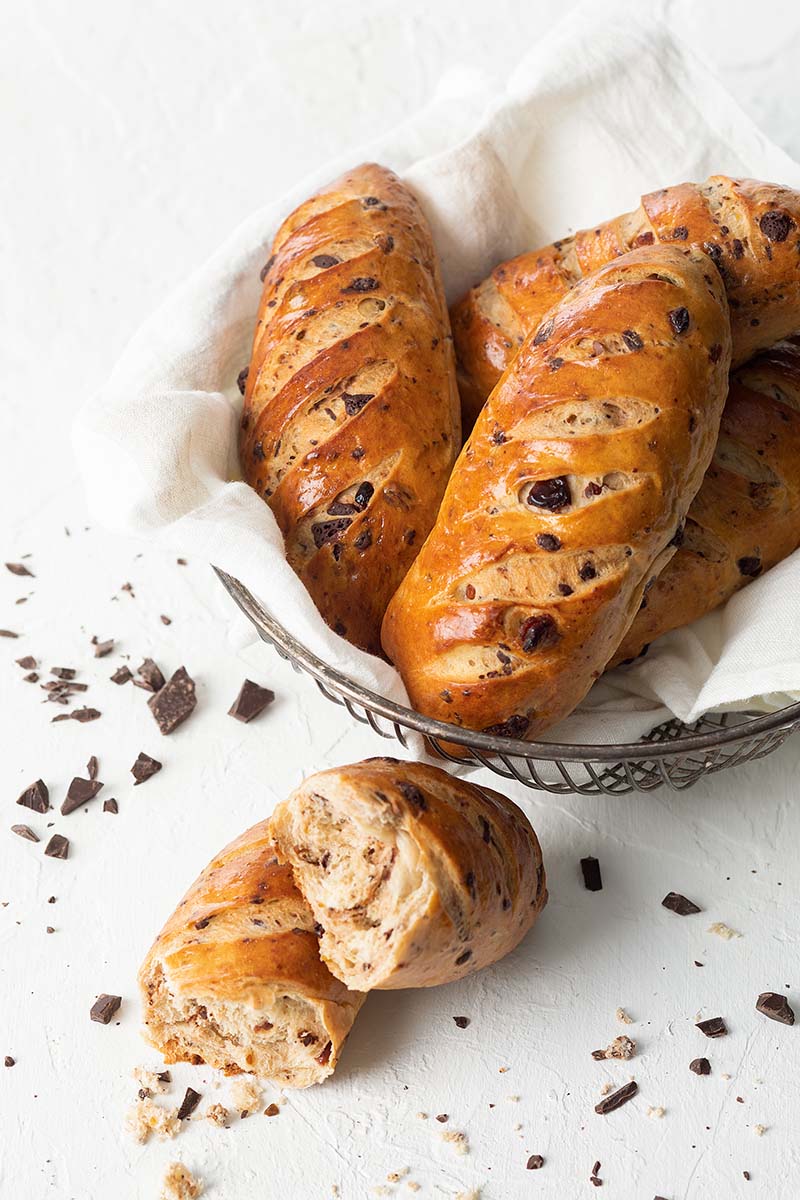Chocolate Cherry & Pistachio Viennoise
Usually enjoyed for breakfast, Viennoise is a special baked good that blends the pleasures of soft milk bread with the buttery richness of brioche. Our enriched dough filled with chocolate, cherries, and pistachios receives a divinely fluffy texture from Platinum Yeast from Red Star.

Yield 7 rolls
Ingredients
- 1/3 cup (80g) warm water (110°F/43°C to 115°F/46°C)
- 1/4 cup (60g) warm whole milk (110°F/43°C to 115°F/46°C)
- 1 (0.25oz) package (7g) Platinum Yeast
- 1/4 cup (50g) granulated sugar, divided
- 3 1/4 cups (406g) all-purpose flour, divided
- 2 1/2 teaspoons (7.5g) kosher salt (see note 1)
- 3 large (150g) eggs, room temperature and divided
- 5 tablespoons (70g) unsalted butter, room temperature (see note 2)
- 1/3 cup (53g) finely chopped bittersweet chocolate
- 1/3 cup (43g) finely chopped dried sweetened cherries
- 1/4 cup (32g) finely chopped dry-roasted salted pistachios
Instructions
- In a small bowl, stir together ⅓ cup (80g) warm water, warm milk, yeast, and 1 teaspoon (4g) sugar. Let stand until foamy, 5 to 10 minutes.
- In the bowl of a stand mixer, whisk together 2¾ cups (344g) flour, salt, and remaining 3 tablespoons plus 2 teaspoons (46g) sugar. Add yeast mixture and 2 eggs (100g); using the paddle attachment, beat at low speed until a shaggy dough forms. Scrape sides of bowl.
- Switch to the dough hook attachment. Beat at low speed until dough is smooth and elastic, about 6 minutes; add up to ¼ cup (32g) flour, 1 tablespoon (8g) at a time, if dough is too sticky. Add butter, 1 tablespoon (14g) at a time, beating until combined after each addition (about 5 minutes total). Beat until a smooth, slightly tacky, and elastic dough forms, 9 to 10 minutes; add up to remaining 1/4 cup (32g) flour, 1 tablespoon (8g) at a time, if dough is too sticky.
- In a small bowl, stir together chocolate, cherries, and pistachios. Add to dough, and beat at low speed until just combined, stopping to scrape sides of bowl and dough hook. Turn out onto a lightly floured surface, and knead 3 to 5 times to ensure mix-ins are evenly distributed. Shape dough into a smooth round.
- Lightly oil a large bowl. Place dough in bowl, turning to grease top. Cover and let rise in a warm, draft-free place (75°F/24°C) until doubled in size, 45 minutes to 1 hour.
- Punch down dough, and let stand for 10 to 15 minutes. On a lightly floured surface, divide dough into 7 portions (about 127g each). Press each portion into a disk about ¾-inch thick. Working clockwise around each disk, fold edges toward center to form a ball. Turn dough seam side down. Cover and let stand for 15 to 20 minutes.
- Line a baking sheet with parchment paper.
- On a lightly floured surface, place 1 dough ball seam side up, and press into a 3¼-inch-wide disk. Starting with top edge, fold dough, about ½ inch at a time, pressing to seal after each fold. Repeat until you have a tight cylinder. Roll seal to bottom, and using both hands, gently roll from center out toward ends, lengthening dough as you go and tapering ends. Dough should be 7 inches long. Repeat with remaining dough. Place, seam side down, about 2 inches apart on prepared pan. Cover and let rise in a warm, draft-free place (75°F/24°C) until doubled in size, 45 minutes to 1 hour.
- Preheat oven to 375°F (190°C).
- In a small bowl, lightly whisk remaining 1 egg (50g). Brush tops and sides of each roll with egg wash. Using a lame or a sharp paring knife, score tops with small diagonal cuts, about ½ inch apart.
- Bake until an instant-read thermometer inserted in center registers 190°F (88°C), 10 to 12 minutes. Let cool on pan for 10 minutes. Serve warm, or remove from pan, and let cool completely on a wire rack.
Notes
- Salt weight and volume vary by brand. Diamond Crystal kosher salt was used in this recipe (1 tablespoon is 9 grams). If you a have different brand or type of salt, use the weight listed in the recipe, not the volume measurement. If you do not have a scale, check your brand’s website for what the equivalent volume measurement is for the weight listed in this recipe.
- Unlike softened butter, room temperature butter should provide no resistance when pressed with a finger. At this point, the butter is soft enough to easily incorporate into your dough.